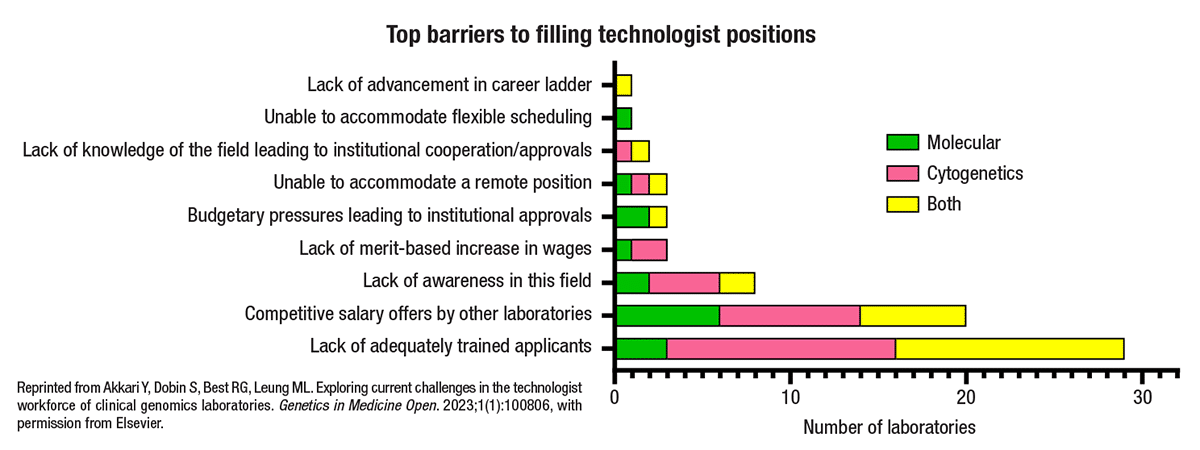Amy Carpenter
March 2024—From a technologist workforce perspective, clinical genomics laboratories are in trouble.
“It’s truly a crisis,” said Marco Leung, PhD, clinical director of the Steve and Cindy Rasmussen Institute for Genomic Medicine at Nationwide Children’s Hospital in Columbus, Ohio, speaking last fall in an Association for Molecular Pathology annual meeting session. “Without technologists there will be no science and no test results coming out of the genomics laboratories.”
Listserv comments and widespread worry about the shortage led to a group of laboratory directors gathering to talk at the American College of Medical Genetics and Genomics annual meeting in 2022. Recruitment, retention, state-specific requirements—all the usual things were up for discussion. “And one of the big things we also talked about was the need to collect data to show the existence of the shortage to administrators and hospital higher-ups to make them aware of the current state.”
“Very little has been published to inform the fundamental reasons behind this shortage,” said Dr. Leung, who is also assistant professor in the pathology and pediatrics departments at Ohio State University College of Medicine.

Dr. Leung
He and coauthors (Yassmine Akkari, PhD; Bob Best, PhD; and Sheila Dobin, PhD) wrote a technologist-based survey targeting clinical directors of CLIA-certified, U.S.-based molecular and cytogenetics laboratories in which staff perform germline or cancer genomics testing, or both. An email with the survey link was sent in July 2022 to more than 330 laboratory directors, identified using the Genetic Testing Registry (through the National Library of Medicine) and via professional connections, and announced on the American Cytogenomics Conference email listserv.
“Ninety-one entries were initiated on the demographic questions, and of these, 70 had answered some portion of the workforce questions and were used for downstream analysis,” Dr. Leung said (Akkari Y, et al. Genet Med Open. Published online March 27, 2023. doi:10.1016/j.gimo.2023.100806). Respondents were evenly distributed across the United States. Fifty laboratories were affiliated with a university or medical center and 10 with a community hospital. (Four were commercial/industry-affiliated, one was government-affiliated, and five were classified as other.) Twenty-nine of the represented laboratories specialized in cytogenetics, 16 in molecular, and 25 in both.
The top three reasons respondents said technologist positions were difficult to fill were the lack of adequately trained applicants (29/70), other laboratories offering competitive salaries (20/70), and a lack of awareness in this field (8/70).
The top cited reason—lack of adequately trained applicants—is “perhaps not too surprising,” Dr. Leung said, “because according to NAACLS [National Accrediting Agency for Clinical Laboratory Sciences] there are only two accredited cytogenetics programs and eight accredited molecular programs” as of October 2023. “There’s such a big difference compared to more than 240 medical laboratory scientist programs. There are just not enough programs for people to get trained in.”
Of the competitive salary offers by other laboratories, he said, “Compensation in the industry is generally higher than in an academic institution.” But with so few industry laboratory respondents, he said, “this is not something we can truly compare.” Many COVID-19 testing laboratories launched during the pandemic did draw away some molecular technologists from noncommercial institutions, he noted.
Dr. Leung agrees that students generally are not aware of cytogenetics. “People have gone through an undergraduate biology degree and probably still have not heard of cytogenetics,” he said. In open-ended comments, one laboratory director wrote: “I truly believe that students are not aware that the field of cytogenetics exists. We need to introduce this field to students at the college level or even early high school.” Another wrote, “Even hospital administrators think cytogenetics has something to do with cytology.”
The top reason cited for leaving a technologist position was having another job offer with a higher salary (20/67), and an approximately equal number categorized their reason as “other.” Twelve of 67 said it was to pursue further education or training, and seven of 67 said it was a loss of interest or dissatisfaction in the position.
 Of the 70 laboratories that provided data, the average number of open positions in the prior two years was 4.24, with no difference noted between the two specialties, Dr. Leung said. But in the number of open positions that had gone unfilled, there’s “a striking difference between molecular and cytogenetics and combined laboratories.” In molecular laboratories about 10 percent of the open positions were not filled, compared with 31 percent in cytogenetics laboratories and 44 percent in laboratories that do both. Molecular laboratories had an average of 6.73 applications per position compared with 3.38 for cytogenetics laboratories and 3.88 for combined laboratories.
Of the 70 laboratories that provided data, the average number of open positions in the prior two years was 4.24, with no difference noted between the two specialties, Dr. Leung said. But in the number of open positions that had gone unfilled, there’s “a striking difference between molecular and cytogenetics and combined laboratories.” In molecular laboratories about 10 percent of the open positions were not filled, compared with 31 percent in cytogenetics laboratories and 44 percent in laboratories that do both. Molecular laboratories had an average of 6.73 applications per position compared with 3.38 for cytogenetics laboratories and 3.88 for combined laboratories.
 CAP TODAY Pathology/Laboratory Medicine/Laboratory Management
CAP TODAY Pathology/Laboratory Medicine/Laboratory Management
